Introduction to Broadband and Convergence
How to Choose the Right Communication Bearers
Pros and Cons of Satellite
Sometimes the nature of the terrain or the remoteness of the location or the sheer expanse of the area or the challenge of communicating with vessels at sea is too much even for LMR’s solid coverage. In such cases satellite communications is an option.
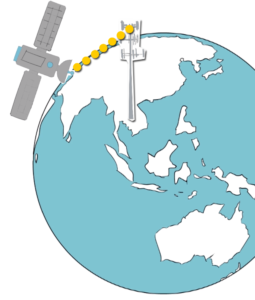 A communications satellite, parked in an orbit above the Earth, receives radio signals transmitted from a ground station which has a parabolic dish antenna aimed at it. The satellite amplifies the signals and re-transmits them to be received by appropriately aimed dishes located at multiple ground stations back on Earth.
A communications satellite, parked in an orbit above the Earth, receives radio signals transmitted from a ground station which has a parabolic dish antenna aimed at it. The satellite amplifies the signals and re-transmits them to be received by appropriately aimed dishes located at multiple ground stations back on Earth.
A comms satellite can create a vital communications link between widely spaced locations on Earth, thus providing high-bandwidth channels to carry voice, data, video or internet. Mining production, oil and gas exploration, and national security have all used satellite in conjunction with other technologies to bring communications to locations that are otherwise difficult or prohibitively expensive to reach using terrestrial technologies.
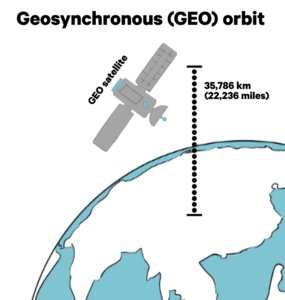
The satellites themselves can be parked in various types of orbits above the Earth. In a geosynchronous (GEO) orbit the satellite follows a high-altitude path (35,786 km (22,236 miles)) with a speed matching the earth’s rate of rotation. This allows the satellite to appear to be fixed over the same location on Earth.
A geostationary orbit is a special case of this type, where the path is directly above the Earth’s equator. Comms satellites are commonly placed in geostationary orbits since the satellite dishes on the ground can simply point to the same fixed position in the sky and don’t need constant re-alignment to track the satellite. GEO satellites provide unrivalled comms coverage, requiring only 3 or 4 to cover most of the Earth.
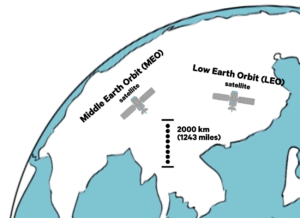 Closer to Earth, Middle Earth Orbit (MEO) satellites – circling at between 2,000 km (1,243 miles) and GEO altitudes – and Low Earth Orbit (LEO) satellites at still lower altitudes – need constant automatic tracking by earthbound dishes or require users to wait for the next available satellite to pass overhead.
Closer to Earth, Middle Earth Orbit (MEO) satellites – circling at between 2,000 km (1,243 miles) and GEO altitudes – and Low Earth Orbit (LEO) satellites at still lower altitudes – need constant automatic tracking by earthbound dishes or require users to wait for the next available satellite to pass overhead.
Communications satellites can use assorted radio and microwave frequencies, but international agreements aimed at minimizing communications chaos restrict their operation to specific bands (e.g. C-band (4-6 GHz), Ku (12-18 GHz) and Ka (26-40 GHz) bands).
Higher frequencies such as those in the Ka band provide greater bandwidth and better resolution but are more susceptible to ‘rain fade’ i.e. the absorption of radio signals by rain or snow in the atmosphere. Hence, in locations with regular rainfall or blizzards, the favored option is to use C-band frequencies despite their reduced bandwidth. This has made C-band almost too popular, with congestion in lower frequencies a major issue for satellite providers. (A less favored option is to use higher Ka or Ku frequencies but with more power to compensate for the signal loss due to rain fade.)
Bouncing a signal up to a satellite and down again takes time – up to half a second for a round trip for a GEO satellite and slightly less for MEO or LEO satellites closer to Earth. This high network latency, which affects all satellite communications, can rule out some applications, such as remote real-time control of machinery.
Although satellite networks are themselves extremely reliable (often quoting 99.7% availability), a satellite nevertheless represents a single point of failure, vulnerable to damage from orbiting debris or solar flares which can be difficult to repair. MEO and LEO satellites are more exposed to space debris and, unlike GEO satellites, experience atmospheric drag which causes their orbits to decay and leads to loss of altitude.

The rapid expansion of satellite communications has also created a growing problem of interference between adjacent satellites in an increasingly crowded sky. Where possible, a satellite-based system design should include provision for redundancy or alternative terrestrial communications to ensure access to communications is always available.
Portable Satellite Antenna and Modem
Satellite services such as BGAN (Broadband Global Area Network) offer briefcase-size portable battery-powered terminals into which a user can plug a phone, laptop or other smart device to make telephone calls or access applications on the Internet via theBritish company Inmarsat’s constellation of geosynchronous satellites. U.S. company Iridium offers similar services and products.
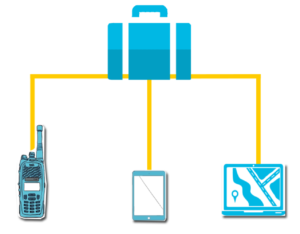
The BGAN plug and play terminals are easy to operate, needing only to be pointed in the general direction of the right satellite to get a connection at speeds for both uplink and downlink of up to 492 kb/s. While this may be a bit sluggish for web surfing, it is good enough to support basic Internet access, set up a VPN connection, send email, have two-way voice conversations, transfer files, and even some video conferencing and streaming IP.
The big issue with using services like these is cost, since you are paying either by flat rate or by the minute or by the megabyte. There are options for controlling cost, with companies offering different charging models, but to get the best of them it is necessary to have a clear idea of where satellite comms should be deployed as opposed to terrestrial alternatives.
VSAT
Alternatively, VSAT (Very Small Aperture Terminal) satellite communications systems can be set up with a two-way ground station connected to a dish antenna that points to or tracks a particular satellite.
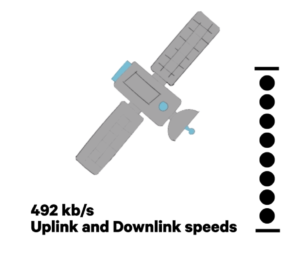
VSAT systems, which may be either fixed or mobile, can provide open standard IP-based Internet services such as email, web access, streaming video, voice over IP telephone, telemetry data transfer, or connection to business networks. VSAT data rates vary between 4 kb/s and 16 Mb/s, but unlike LMR, most VSATs are capable of supporting broadband data applications. VSAT sites can be networked together to connect back to a network operations center, command center or corporate headquarters.
VSAT equipment is available through a number of companies. VSAT is relatively inexpensive to buy, can be installed at a fixed site or in a vehicle, can be re-located quickly when needed, and is easy to operate. Most VSAT terminals operate in the more cost-effective Ku band or, increasingly, the Ka band.
Part of the reason for this lies in the convenience of their smaller dish antennas (74-120 cm. diameter). In contrast, C-band VSAT terminals can have dishes up to 4 meters in diameter – a bit too large for operation out of a typical vehicle!
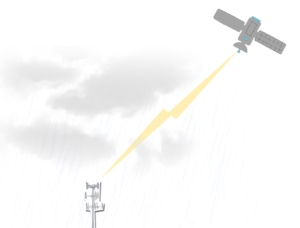 However, using VSAT requires a clear line of sight between the dish antenna and the satellite, which can be an issue for system design and operation. On a vessel rocking in a stormy sea, line-of-sight can be a struggle to achieve. Gyrostabilized antennas help, but in moderately rough conditions a lot of comms errors and retries can accumulate, degrading the usefulness of the connection. On land, a heavy tree canopy, new buildings, mine dumps, changes in local topography, or simply knocking the dish out of true can impede line-of-sight and thereby disrupt a VSAT connection.
However, using VSAT requires a clear line of sight between the dish antenna and the satellite, which can be an issue for system design and operation. On a vessel rocking in a stormy sea, line-of-sight can be a struggle to achieve. Gyrostabilized antennas help, but in moderately rough conditions a lot of comms errors and retries can accumulate, degrading the usefulness of the connection. On land, a heavy tree canopy, new buildings, mine dumps, changes in local topography, or simply knocking the dish out of true can impede line-of-sight and thereby disrupt a VSAT connection.
To provide wide-area linking across multiple sites (e.g. exploration camps) VSATs can be directly connected to each other in a mesh configuration. Or for centralized management and control each VSAT can be joined to a central hub ground station in star configuration. Both designs give additional routes for communication in case one or more of the VSATs fail or are unavailable.
By combining VSAT with other network bearers such as WiFi, cellular, LMR, or IP over ethernet, a variety of fully-functioned communication systems can be designed for remote locations without sacrificing connection to the rest of a critical communications system. Security is provided by encrypting voice and data communications as well as the ability to set up virtual private networks.
The big issue with using services like BGAN or Iridium or VSAT is cost, since you are paying either by a flat rate or by the minute or by the megabyte. The cost per megabyte is very high compared to terrestrial technologies. There are options for controlling cost, with companies offering different charging models, but to get the best of them it is necessary to have a clear idea of where satellite comms should be deployed as opposed to terrestrial alternatives.
Nevertheless, adding satellite as a bearer to a multi-technology solution, brings a whole new level of additional coverage, accessibility and communications flexibility.
 Radio Academy
Radio Academy




